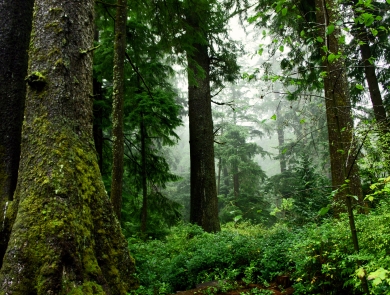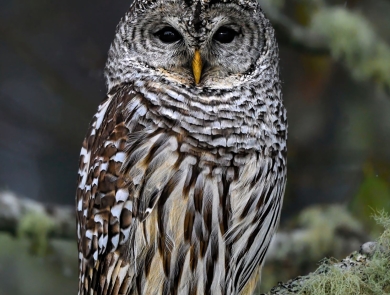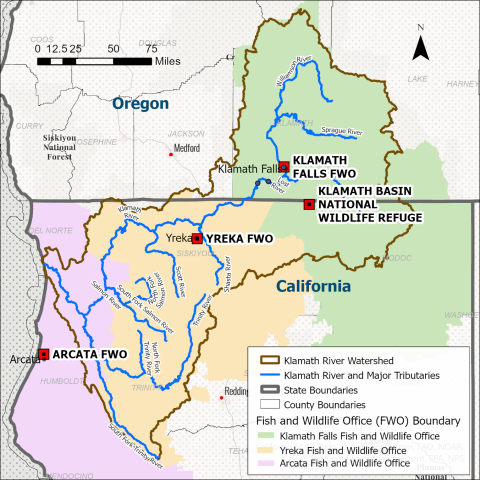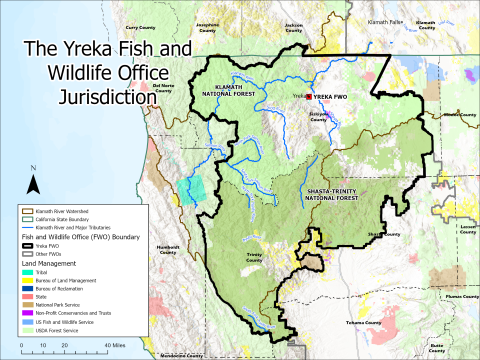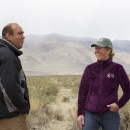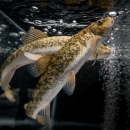About Us
The Yreka Fish and Wildlife Office (Yreka FWO) is an Ecological Services Office located in Siskiyou County, northern California a few miles south of the Oregon border. Our office supports conservation work within the Shasta-Trinity and Klamath National Forests and adjoining private lands within Siskiyou, Trinity, and Shasta Counties. It was established in 1987 as the Klamath River Fisheries Resource Office and has evolved over time to include programs focused on the conservation and recovery of threatened, endangered, and at-risk species, and the restoration of forest and riparian riparian
Definition of riparian habitat or riparian areas.
Learn more about riparian habitats.
Covering almost 6 million acres (over 9,000 square miles), the Yreka FWO is one of four U.S. Fish and Wildlife Service offices in the Klamath River watershed. These include the Klamath Basin National Wildlife Refuge Complex headquartered in Tulelake, CA, the Klamath Falls Fish and Wildlife Office in Oregon, and the Arcata Fish and Wildlife Office on the northern California coast.
The Yreka FWO covers the mid-Klamath watershed, which has a rich cultural and natural history that includes Tribal, mining, timber management, farming and ranching activities. It was part of the California gold rush with miles of tailings yet to be restored in the Scott, Shasta, and Klamath River drainages. Surrounded by forests, wildfire and fuels management are a central focus of our office work.
Conserving fish and wildlife cannot be successful without the partnership of local Tribes. The mid-Klamath is home to the Karuk and Quartz Valley Tribes, with whom the Yreka FWO works collaboratively to maintain, strengthen, and promote positive working relationships for the future of the Klamath River watershed.
What We Do
The Yreka Fish and Wildlife Office is involved in numerous habitat and wildlife restoration projects in the region. Our area of coverage ranges from the California/Oregon border along the I-5 corridor, and includes Siskiyou, Shasta, Trinity and Tehama counties. We also support other FWOs on projects with species having overlapping jurisdictions.
Our Organization
The Yreka FWO performs work under several USFWS program areas, including Ecological Services, Partners for Fish and Wildlife, Fish and Aquatic Conservation and Habitat Restoration. We also have a Native American Program Specialist, a Public Affairs Officer and a team of Administrative professionals who manage the many grants, budgets, personnel matters to keep the office running smoothly and efficiently.
Our Species
One of the main roles of the Yreka FWO is consultation with other Federal agencies on projects that may affect species or their critical habitat as listed under the Endangered Species Act (ESA). This is important because all federal agencies, not just the Fish and Wildlife Service, have a responsibility to conserve listed species and critical habitat.
Yreka FWO biologists monitor the status and support the recovery of several species of rare fish, wildlife, and plants, from furry mammals like the fisher, to the old-growth forest dwelling Northern spotted owl, to the small and secretive Shasta salamander group, the elusive Franklin's bumble bee, and colorful plants like the Yreka phlox. We work with landowners and leading scientists to gather the best available science on each species and their habitat, and work with our many partners to implement on-the-ground conservation that supports their recovery.
Our Library
The Yreka FWO began producing a semi-annual newsletter as a means to share the successes of our office, the people who make conservation happen, and some of the compelling species we are responsible for managing in the northern part of California. All content is written by our staff of biologists whose passion for their work is evident in their words. Each issue has a theme for the type of species or projects featured, a profile of one of our talented staff members, and a species spotlight.
These issues are the best way to learn more about what we do and our many collaborative efforts to conserve the uniqueness of the Klamath Basin ecosystem.
Get Involved
A connection with nature is important, whether you are a child or an adult. Exploring nature encourages the use of imagination, use of the five senses, and provides an outlet from day to day routines. Children are future naturalists and conservationists, so the stronger we encourage their bonds with nature, the stronger their resolve will be to enjoy and conserve nature.
There are a number of opportunities to connect with nature in the Yreka, California area:
- Visit local parks
- Go hiking or take a walk
- Visit a state Wildlife Area
- Explore the Klamath National Forest
- Plant a garden
- Volunteer for conservation projects in your local community




